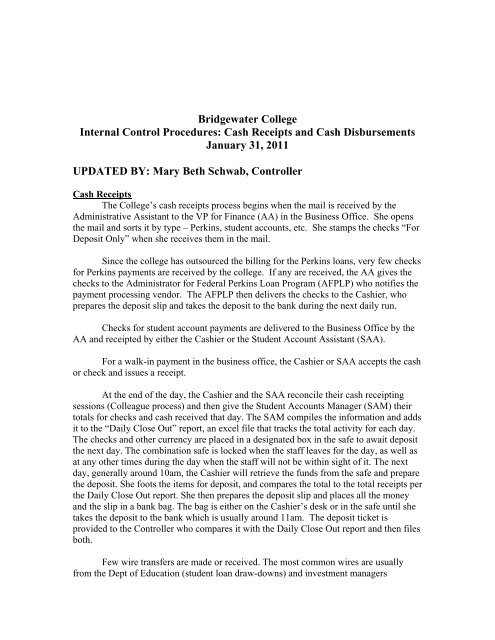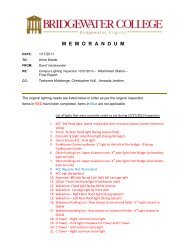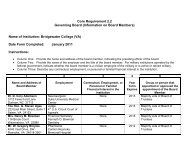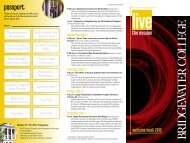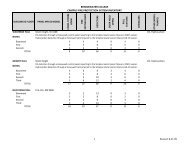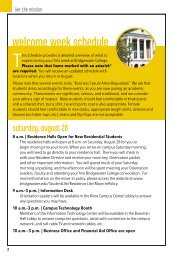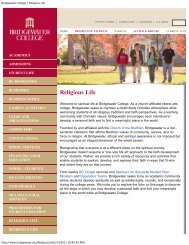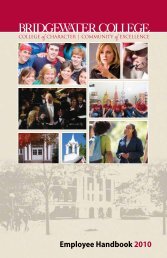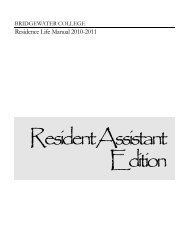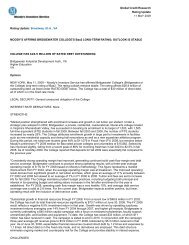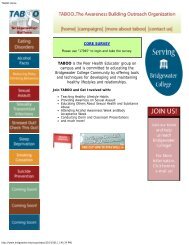Cash Transaction Procedures
Cash Transaction Procedures
Cash Transaction Procedures
Create successful ePaper yourself
Turn your PDF publications into a flip-book with our unique Google optimized e-Paper software.
Bridgewater College<br />
Internal Control <strong>Procedures</strong>: <strong>Cash</strong> Receipts and <strong>Cash</strong> Disbursements<br />
January 31, 2011<br />
UPDATED BY: Mary Beth Schwab, Controller<br />
<strong>Cash</strong> Receipts<br />
The College’s cash receipts process begins when the mail is received by the<br />
Administrative Assistant to the VP for Finance (AA) in the Business Office. She opens<br />
the mail and sorts it by type – Perkins, student accounts, etc. She stamps the checks “For<br />
Deposit Only” when she receives them in the mail.<br />
Since the college has outsourced the billing for the Perkins loans, very few checks<br />
for Perkins payments are received by the college. If any are received, the AA gives the<br />
checks to the Administrator for Federal Perkins Loan Program (AFPLP) who notifies the<br />
payment processing vendor. The AFPLP then delivers the checks to the <strong>Cash</strong>ier, who<br />
prepares the deposit slip and takes the deposit to the bank during the next daily run.<br />
Checks for student account payments are delivered to the Business Office by the<br />
AA and receipted by either the <strong>Cash</strong>ier or the Student Account Assistant (SAA).<br />
For a walk-in payment in the business office, the <strong>Cash</strong>ier or SAA accepts the cash<br />
or check and issues a receipt.<br />
At the end of the day, the <strong>Cash</strong>ier and the SAA reconcile their cash receipting<br />
sessions (Colleague process) and then give the Student Accounts Manager (SAM) their<br />
totals for checks and cash received that day. The SAM compiles the information and adds<br />
it to the “Daily Close Out” report, an excel file that tracks the total activity for each day.<br />
The checks and other currency are placed in a designated box in the safe to await deposit<br />
the next day. The combination safe is locked when the staff leaves for the day, as well as<br />
at any other times during the day when the staff will not be within sight of it. The next<br />
day, generally around 10am, the <strong>Cash</strong>ier will retrieve the funds from the safe and prepare<br />
the deposit. She foots the items for deposit, and compares the total to the total receipts per<br />
the Daily Close Out report. She then prepares the deposit slip and places all the money<br />
and the slip in a bank bag. The bag is either on the <strong>Cash</strong>ier’s desk or in the safe until she<br />
takes the deposit to the bank which is usually around 11am. The deposit ticket is<br />
provided to the Controller who compares it with the Daily Close Out report and then files<br />
both.<br />
Few wire transfers are made or received. The most common wires are usually<br />
from the Dept of Education (student loan draw-downs) and investment managers
(investment fund calls or reallocation transfers). The College requests advance<br />
notification for incoming wires, and most agencies provide such notification. Investment<br />
accounts are established with authorized account(s) – generally, only one - to which the<br />
investment firms can transfer funds. To add an account to the list, the fund managers<br />
typically request significant documentation, sometimes a board resolution. These<br />
industry-standard requirements of the fund managers mitigate the risk of any individual at<br />
the College directing funds into an unauthorized account. Other agencies provide<br />
different types of controls. The Commonwealth of Virginia, for example, sends emails to<br />
at least two individuals at the College before transferring funds into a designated College<br />
bank account for the state tuition assistance program.<br />
<strong>Cash</strong> is sometimes received by departments other than the business office. An<br />
example of such receipts would be athletic event concessions, t-shirts sold for a<br />
fundraiser, etc. In these cases the department collects the money and then brings it into<br />
the business office with a checklist. If the activity occurs after business hours, the<br />
department places the deposit into a locking bank bag and puts it into one of the two safes<br />
located outside the business office. One safe is in Nininger Hall and the other is in the<br />
Kline Campus Center. The safes have two compartments with a drop slot into the top<br />
compartment. The department notifies the Campus Police and Safety Department to<br />
request a cash transfer. Either the Chief of Campus Police or the Sergeant of Campus<br />
Police delivers the deposit to the business office the next morning. The Controller is the<br />
only other person, besides the two named individuals from Campus Police, who has<br />
access to the top compartment of the safes. The bottom compartments are used to secure<br />
any petty cash funds before the event. The departments control the combination to the<br />
bottom compartment.<br />
<strong>Procedures</strong> for the receipt of cash, checks and securities as donations are<br />
established jointly between the Office of Institutional Advancement and Finance. See<br />
OIA Contribution Processing <strong>Procedures</strong> for these procedures.<br />
<strong>Cash</strong> Disbursements<br />
For disbursements made by check, the process is mostly performed by the<br />
Accounts Payable Manager (APM) in accounts payable. The APM receives a voucher or<br />
purchase order, approved from the appropriate department chair, with a general ledger<br />
account number assigned. Sometimes the request comes via email. The APM is<br />
responsible for contacting the department chair/manager for any missing GL numbers.<br />
For invoices received directly by the APM, the APM first attempts to match the invoice<br />
to an approved purchase order. If there is a match and all items from the invoice have<br />
been properly received by the ordering department, then the invoice can be paid without<br />
additional processing. Any discrepancies are resolved by the APM with the ordering<br />
department before vendor payment is initiated. Some invoices are first received by the<br />
ordering departments and are approved by the department chair/manager and then sent to<br />
the APM to be paid. The APM runs accounts payable checks on Mondays and Thursdays.<br />
See AP Check Processing Procedure for more details. After checks are written, the<br />
Controller transmits a file to the bank which includes the check number, check amount<br />
and the payee information. Any check that is presented for payment which is not on file
with the bank is flagged and must be approved for payment by the Controller on the bank<br />
website. If it is not approved, the check will be returned.<br />
Accounts payable checks are posted into the general ledger by the Controller. The<br />
backup position for this task is the AA.<br />
Checks are issued by the APM for employee travel advances upon receipt of a<br />
properly approved form in the business office. Faculty travel advances require prior<br />
approval by the Academic Dean. The employee then must return any money with receipts<br />
to the cashier when their trip is complete. The Controller generates a list of outstanding<br />
travel advances. Employees with advances outstanding longer than two weeks may not<br />
receive another travel advance and after a month, the list of outstanding advances is<br />
reported to the appropriate vice president for handling.<br />
Petty cash may be used to reimburse employees for authorized purchases of less<br />
than $25. A form with the necessary approvals is required before the funds are<br />
reimbursed. The employee signs the petty cash form to indicate that they received the<br />
funds. The Controller reconciles the petty cash box every two weeks and submits a<br />
request for reimbursement of the funds.<br />
To initiate an outgoing wire transfer, the Controller or the VP calls the bank wire<br />
room to initiate the transfer; an individually-assigned pin number is required and the bank<br />
periodically changes the pin number. The only employees with a pin number are the VP<br />
for Finance, the Controller and the President. Some, but not all, of the investment<br />
managers will call to verify that the transfer is legitimate. After the wire has been sent,<br />
the Controller will confirm receipt with the destination agency. The bank randomly calls<br />
an authorized person other than the person initiating a wire, for verification; the pin<br />
number and wire details (amount, destination account, etc.) are required for that<br />
verification.


